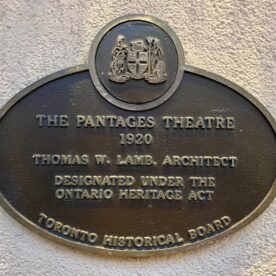Yesterday morning I had a chance to visit the Adamson Estate in Lakeview, Mississauga which is just east of Port Credit. It certainly wasn’t my first visit, as I grew up nearby and fondly remember attending several summer church bible camps on the property, but it was the first time I’d been back since it was turned into a public park.
It was, and continues to be, a fascinating place to explore. The property is right on the lake so even without the interesting buildings and pet cemetery on the site, it is a wonderful location to reconnect with nature.
The settler history of the site goes back to Joseph Cawthra, who was given a 400 acre (some sources say 200 acre) parcel of land around 1809 which he mainly used as a farm and summer residence. The site is located on the Traditional Territory and Treaty Lands of the Mississaugas of the Credit First Nation and had been purchased by the British crown in 1806 in ‘Treaty 14’, also known as the ‘Head of the Lake Purchase’.
Joseph Cawthra was a merchant and prominent political reformer, like William Lyon Mackenzie. He had many children and the impact of the Cawthra family on parts of southern Ontario is worthy of its own exploration. When Cawthra’s granddaughter Mabel married Agar Adamson they were given a nearby lakefront property and it remained in the family until the 1970s.
The first structure you see when driving into the parking lot is the barn. The wooden portions have recently been rebuilt but the foundation of the barn, built with field stones and mortar, dates to 1870. The farm once, like several others along the lakeshore, had a large grove of white pine trees that were reserved for use as ship masts by the Royal Navy. It was known as “Grove Farm”. For many years from the 1960s on, the barn was used for theatrical productions.
The main house, built in the Colonial Revival Style with Flemish elements and which now houses a private school (Blyth Academy), was home to the Royal Conservatory of Music when I was a child. It was built over the winter of 1919-1920. There had originally been both an 1809 log cabin and an 1866 summer cottage on the site, both a little closer to the water than this home. I couldn’t access it yesterday but I have been inside when I attended camp here. This is where the washrooms were, but that was only time we were allowed inside and we always had to very quiet. I wish I could show you the picture in my mind of what I remember! There was always beautiful music, mostly piano that I recall, tinkling from the house when the windows were open on hot summer days.
The gatehouse or folly, was built around 1904 and it is one of only three of this design in Canada. The other two are in Ottawa at the residences of the Prime Minister and the Governor General. And this one is the only wooden folly remaining in Canada. The upstairs was once a nursery for Anthony Adamson, Mabel and Agar’s younger son Anthony, who was born in 1906. (I suppose the elder son Agar, born in 1901, must have had a nursery in the main home.) The folly later held the mechanical equipment and change rooms for the 1956 swimming pool that was on the site, the remains of which are a sunken garden today. There are two posters mounted to the building with some historical information about the site. I’m pretty sure I have spent some time upstairs in the old nursery and guest room, on days when it rained at camp.
To the east of the main house and modern parking lot, there is the Derry House. It was built in 1932 by Anthony Adamson in the Regency and Greek Revival styles. He and his wife Augusta lived here until they moved into the main house in 1943 after the deaths of his parents. The house was then sold to the Derry family, hence its name. Anthony Adamson was awarded the Order of Canada for his contribution to Canadian Architecture in 1974 and was a Professor at the University of Toronto, known as a leader in architectural conservation and architectural studies.
By 1968 there were only 15 acres of the original property left that had not been sold off. Anthony Adamson applied to the city for permission to develop the site for apartment buildings and in 1972 the city rezoned it for high rises. However, neighbours sent in letters of objection and the land was expropriated and saved. The estate received heritage designation in 1978 and the Derry House received its heritage designation in 1993.
Scattered over the property were many memorials to beloved pets of the Adamson family; today they are collected into a beautiful little memorial pet cemetery. 
In recent years, new paths through the regenerating woodlots have been laid, public parking has been added and it is a site easily accessible to the public from the main road and trails from nearby parks. And March Break was a great time to visit because the school was closed.




Leave a Reply